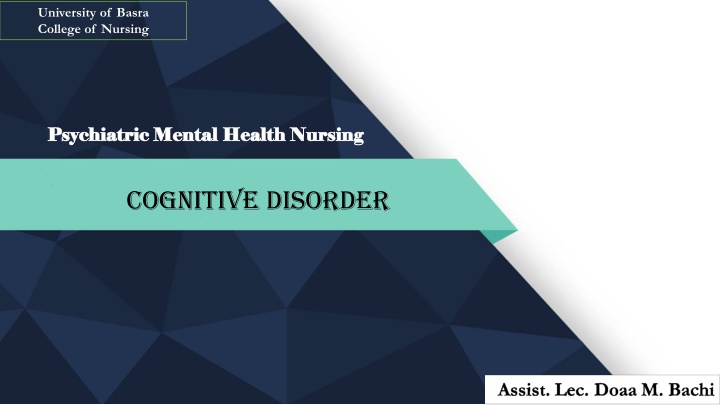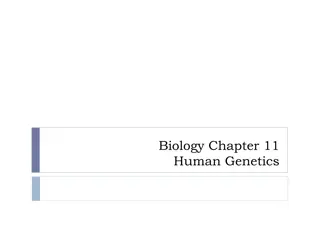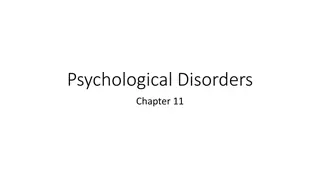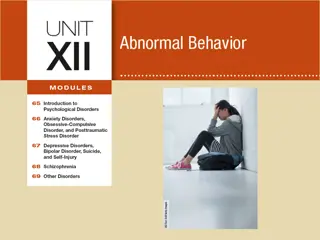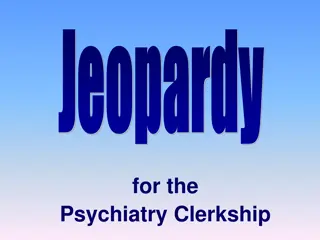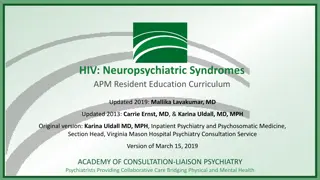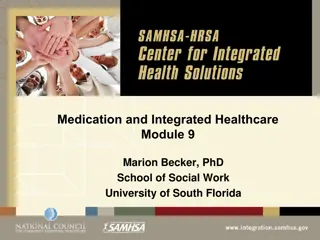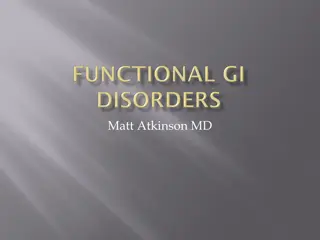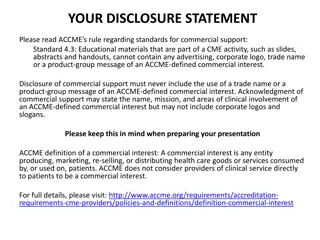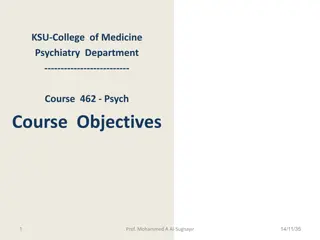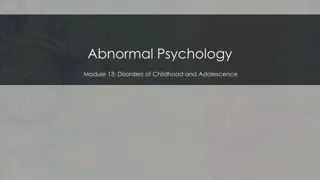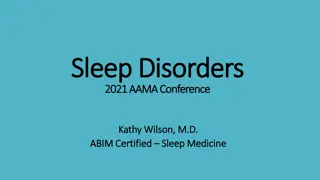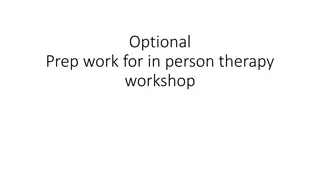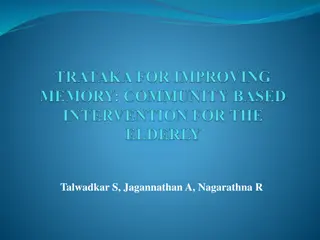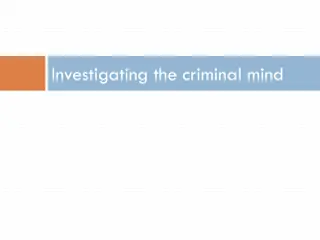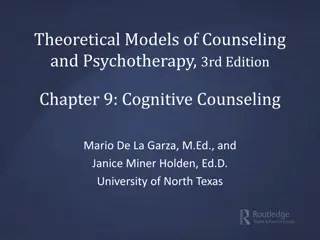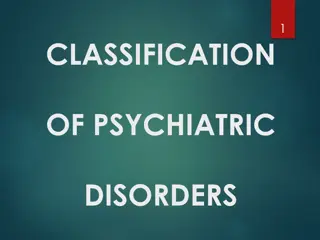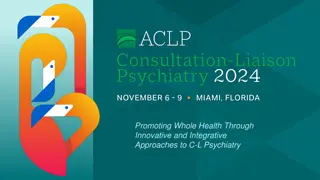Cognitive Disorders in Psychiatry: A Comprehensive Overview
Cognitive disorders disrupt higher brain functions, impacting memory, attention, and decision-making abilities. This article explores the classification of cognitive disorders, focusing on delirium, a common syndrome characterized by consciousness disturbance and cognitive changes. Delirium predominantly affects elderly patients and those with terminal illnesses, showcasing symptoms like attention difficulties, hallucinations, and emotional disturbances. Early recognition and management are crucial in mitigating the impact of these disorders.
Uploaded on Sep 23, 2024 | 8 Views
Download Presentation

Please find below an Image/Link to download the presentation.
The content on the website is provided AS IS for your information and personal use only. It may not be sold, licensed, or shared on other websites without obtaining consent from the author.If you encounter any issues during the download, it is possible that the publisher has removed the file from their server.
You are allowed to download the files provided on this website for personal or commercial use, subject to the condition that they are used lawfully. All files are the property of their respective owners.
The content on the website is provided AS IS for your information and personal use only. It may not be sold, licensed, or shared on other websites without obtaining consent from the author.
E N D
Presentation Transcript
University of Basra College of Nursing + Psychiatric Mental Health Nursing Psychiatric Mental Health Nursing Cognitive Disorder
+ Cognition is the brain s ability to process, retain, and use information. Cognitive abilities include reasoning, judgment, perception, attention, comprehension, and memory. These cognitive abilities are essential for many important tasks, including making decisions, solving problems, interpreting the environment, and learning new information.
+ Cognitive Disorder A cognitive disorder is a disruption or impairment in higher level functions of the brain. They can cause people to forget the names of immediate family members, be unable to perform daily household tasks, and neglect personal hygiene.
+Classification of cognitive disorders First : According to The Diagnostic and Statistical Manual of Mental Disorders, fourth edition (DSM-IV) 1. Dementia, 2. Delirium 3. Amnestic disorders. Second : According to The Diagnostic and Statistical Manual of Mental Disorders, Five edition (DSM-V) neurocognitive disorders (NCDs). 1.Delirium 2. Major NCD 3. Mild NCD, and their subtypes by etiology
1. Delirium + Delirium is a syndrome that involves a disturbance of consciousness accompanied by a change in cognition. Delirium usually develops over a short period, sometimes a matter of hours, and fluctuates, or changes, throughout the course of the day. Clients with delirium have difficulty paying attention, are easily distracted and disoriented, and may have sensory disturbances such as illusions, misinterpretations, or hallucinations.
+ Elderly patients are the group most frequently diagnosed with delirium. Between 14% and 24% of people admitted to the hospital for general medical Delirium develops in 80% of terminally ill patients
+ Symptoms 1. Difficulty paying attention, 2. Easily distracted and disoriented 3. hallucinations. Sensory disturbances such as illusions, misinterpretations, or 4. apathy Emotional problems such as anxiety, fear, irritability, euphoria, or 5. Judgment is impaired. 6. Disturbance the sleep wake cycle 7. Changes in psychomotor activity. 8. People who have had delirium are at higher risk for future episodes
Most Common Causes of Delirium Physiological or metabolic + 1. Hypoxemia; electrolyte disturbances; renal or hepatic failure; hypoglycemia or hyperglycemia; dehydration; sleep deprivation; thyroid or glucocorticoid disturbances; thiamine or vitamin B12 deficiency; vitamin C10. Head injury Cardiovascular shock; brain tumor 2. Infection Systemic: Sepsis, urinary tract infection, pneumonia Cerebral: Meningitis, encephalitis, HIV, syphilis 3. Drug related Intoxication: Anticholinergics, lithium, alcohol, sedatives, and hypnotics Withdrawal: Alcohol, sedatives, and hypnotics Reactions to anesthesia, prescription medication, or illicit (street) drugs
Treatment + Clients with quiet, hypoactive delirium need no specific pharmacologic treatment aside from that indicated for the causative condition Sedation to prevent inadvertent self-injury may be indicated. An antipsychotic medication, such as haloperidol (Haldol), may be used in doses of 0.5 to 1 mg to decrease agitation and psychotic symptoms Adequate nutritious food and fluid If a client becomes agitated and threatens to dislodge IV tubing or Catheter Restraints are used only when necessary and stay in place no longer than warranted because they may increase the client s agitation
NURSING DIAGNOSIS For Delirium + Risk for injury Acute confusion Additional diagnoses that are commonly selected based on client assessment include: 1. Disturbed sensory perception 2. Disturbed thought processes 3. Disturbed sleep pattern 4. Risk for deficient fluid volume 5. Risk for imbalanced nutrition: Less than body requirements
NURSING INTERVENTIONS For Delirium + 1. Promoting client s safety Use supportive touch if appropriate. 2. Managing client s confusion Controlling environment to reduce sensory overload 3. Speak to the client in a calm manner in a clear low voice; use simple sentences. Keep environmental noise to minimum (television, radio). Allow adequate time for the client to comprehend and respond. Monitor the client s response to visitors; explain to family and friends that the client may need to visit quietly one-on-one. Allow the client to make decisions as much as he or she is able to. Promoting sleep and proper nutrition 4. Provide orienting verbal cues when talking with the client.
DEMENTIA + Dementia refers to a disease process marked by progressive cognitive impairment with no change in the level of consciousness. It involves multiple cognitive deficits, initially, memory impairment and later, the following cognitive disturbances may be seen ..
+ Aphasia, which is deterioration of language function Apraxia, which is impaired ability to execute motor functions despite intact motor abilities Agnosia, which is inability to recognize or name objects despite intact sensory abilities Disturbance in executive functioning, which is the ability to think abstractly and to plan, initiate, sequence, monitor, and stop complex behavior palilalia (repeating words or sounds over and over).
Onset and Clinical Course + 1. Mild: Forgetfulness is the hallmark of beginning, mild dementia. The person has difficulty finding words, frequently loses objects, and begins to experience anxiety about these losses. 2. Moderate: Confusion is apparent, along with progressive memory loss The person no longer can perform complex tasks but remains oriented to person and place. He or she still recognizes familiar people. 3. Severe: Personality and emotional changes occur. The person may be delusional, wander at night, forget the names of his or her spouse and children.
Etiology + 1. Metabolic activity is decreased in the brains of clients with dementia; it is not known whether dementia causes decreased metabolic activity or if decreased metabolic activity results in dementia. 2. A genetic component has been identified for some dementias, such as Huntington disease. 3. An abnormal APOE gene is known to be linked with Alzheimer disease. 4. Infections cause such as human immunodeficiency virus (HIV) infection or Creutzfeldt Jakob disease 5. Traumatic brain injury
The most common types of dementia + 1. Alzheimer disease is a progressive brain disorder that has a gradual onset but causes an increasing decline in functioning, including loss of speech, loss of motor function, and profound personality and behavioral changes such as paranoia, delusions, hallucinations, inattention to hygiene, and belligerence. onset of symptoms to death is 8 to 10 years 2. NCD with Lewy bodies, or Lewy body dementia, is a disorder that involves progressive cognitive impairment and extensive neuropsychiatric symptoms as well as motor symptoms. Delusions and visual hallucinations are common.
Vascular dementia has symptoms similar to those of Alzheimer disease, + but onset is typically abrupt, followed by rapid changes in functioning; a plateau, or leveling-off period; more abrupt changes; another leveling-off period; and so on. 3. Frontotemporal lobar degeneration (originally called Pick 4. disease) is a degenerative brain disease that particularly affects the frontal and temporal lobes and results in a clinical picture similar to that of Alzheimer disease Prion diseases are caused by a prion (a type of protein) that can trigger 5. normal proteins in the brain to fold abnormally Parkinson disease is a slowly progressive neurologic condition 6. characterized by tremor, rigidity, bradykinesia, and postural instability Huntington disease is an inherited, dominant gene disease that 7. primarily involves cerebral atrophy, demyelination, and enlargement of the brain ventricles.
Substance- or medication-induced mild or major NCD is + characterized by neurocognitive impairment that persists beyond intoxication or withdrawal. The deficits may stabilize or even show some improvement after a sustained period of abstinence. Long-term use of alcohol that results in dementia is called Korsakoff syndrome or dementia. It was previously known as an amnestic disorder since amnesia and confabulation are common Dementia of the Alzheimer type is more common in women; vascular dementia is more common in men.
Treatment and Prognosis + Whenever possible, the underlying cause of dementia is identified so that treatment can be instituted. 1. Drugs led to attempts at replenishment therapy with acetylcholine precursors, cholinergic agonists, and cholinesterase inhibitors. 2. Antidepressants are effective for significant depressive symptom Selective serotonin reuptake inhibitor antidepressants 3. Antipsychotics, such as haloperidol (Haldol), olanzapine (Zyprexa), risperidone (Risperdal), and quetiapine (Seroquel),
NURSING DIAGOSIS For DEMINTIA + 1. Risk for injury 2. Disturbed sleep pattern 3. Risk for deficient fluid volume 4. Risk for imbalanced nutrition: Less than body requirements 5. Chronic confusion 6. Impaired environmental interpretation syndrome 7. Impaired memory 8. Impaired social interaction 9. Impaired verbal communication 10. Ineffective role performance
NURSING INTERVENTIONS For Dementia + Promoting client s safety and protecting from injury Promoting adequate sleep, proper nutrition and hygiene, and activity Encourage mild physical activity such as walking. Encourage the client to follow regular routine and habits of bathing and dressing rather than imposing new ones. Providing emotional support Use supportive touch when appropriate. Reminisce therapy with the client about the past. If the client is nonverbal, remain alert to nonverbal behavior. Employ techniques of distraction, time away, going along, or reframing to calm clients who are agitated, suspicious, or confused
+ Reminiscence therapy (thinking about or relating personally significant past experiences) is an effective intervention for clients with dementia. Reminiscing, also called nostalgia, uses the client s remote memory, which is not affected as severely or quickly as recent or immediate memory. Photo albums may be useful in stimulating remote memory, and they provide a focus on the client s past.
